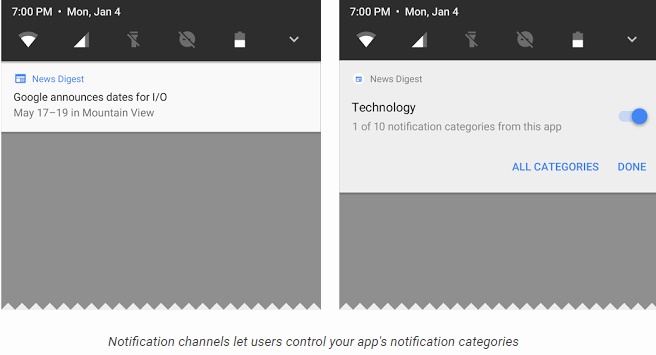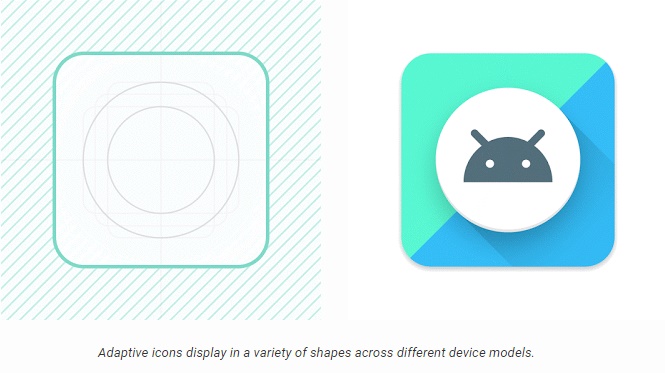Image Source: developer.android.com
This preview goes on to include an updated SDK with system images for Nexus 5X, Nexus 6P, Nexus Player, Pixel, Pixel XL, Pixel C, and the official Android Emulator. It also includes an emulator for testing
Android Wear 2.0 on Android O.
“Today, I'm excited to share a first developer preview of the next version of the OS: Android O. The usual caveats apply: it's early days, there are more features coming, and there's still plenty of stabilization and performance work ahead of us."
Google used to unveil the next Android version and released the accompanying developer preview at its I/O developer conference. However, this was changed last year, with the launch of its first Android N developer preview in March 2016, in addition to the Android Beta Program, which allows you to gain an early Android build via over the air updates on Nexus devices.
Just like Nougat, this year too, Android O gains an early preview, however the first preview has not been made available via Android Beta. Google have made this preview available exclusively by manual download and flash so as to emphasize it only for developers and do not intend it for regular or consumer use.
Other than this, all the rules are the same. This is an early look at the next version of Android, which is being referred to as Android O until Google goes on to pick up a name for starting with that particular letter. The main aim is to allow the developers play with the build early, test their apps, and provide with a feedback before the company goes on to share more details at their I/O conference 2017, scheduled for May 17 to May 19.
The latest preview, which is also the first one, goes on to include the following APIs and features, as per the official blog.
- Background limits: Building on the work in Nougat, Android O puts a big priority on improving a user's battery life and the device's interactive performance. Google has put additional automatic limits on what apps can do in the background, in three main areas: implicit broadcasts, background services, and location updates. These changes will make it easier to create apps that have minimal impact on a user's device and battery.
- Notification channels: Android O also introduces notification channels, which are new app-defined categories for notification content. Channels let developers give users fine-grained control over different kinds of notifications — users can block or change the behavior of each channel individually, rather than managing all of the app's notifications together. Android O also adds new visuals and grouping to notifications that make it easier for users to see what's going on when they have an incoming message or are glancing at the notification shade.

Image Source: android-developers.googleblog.com
- Autofill APIs: Android users already depend on a range of password managers to autofill login details and repetitive information, which makes setting up new apps or placing transactions easier. Now the company is making this work more easily across the ecosystem by adding platform support for autofill. Users can select an autofill app, similar to the way they select a keyboard app. The autofill app stores and secures user data, such as addresses, user names, and even passwords. For apps that want to handle autofill, the company ahs gone on to add new APIs to implement an Autofill service.
- PIP for handsets and new windowing features: Picture in Picture (PIP) display is now available on phones and tablets, so users can continue watching a video while they're answering a chat or hailing a car. Apps can put themselves in PiP mode from the resumed or a pausing state where the system supports it - and you can specify the aspect ratio and a set of custom interactions (such as play/pause). Other new windowing features include a new app overlay window for apps to use instead of system alert window, and multi-display support for launching an activity on a remote display.
- Font resources in XML: Fonts are now a fully supported resource type in Android O. Apps can now use fonts in XML layouts as well as define font families in XML — declaring the font style and weight along with the font files.
- Adaptive icons: To help you integrate better with the device UI, you will now be able to create adaptive icons that the system displays in different shapes, based on a mask selected by the device. The system also animates interactions with the icons, and uses them in the launcher, shortcuts, Settings, sharing dialogs, and in the overview screen.
 Image Source: android-developers.googleblog.com
Image Source: android-developers.googleblog.com- Wide-gamut color for apps: Android developers of imaging apps can now take advantage of new devices that have a wide-gamut color capable display. To display wide gamut images, apps will need to enable a flag in their manifest (per activity) and load bitmaps with an embedded wide color profile.
- Connectivity: For the ultimate in audio fidelity, Android O now also supports high-quality Bluetooth audio codecs such as LDAC codec. The company has also gone ahead and added new Wi-Fi features such as, like Wi-Fi Aware, which has previously been known as Neighbor Awareness Networking (NAN). On devices with the appropriate hardware, apps and nearby devices can discover and communicate over Wi-Fi without an Internet access point. Google is working with the hardware partners to bring Wi-Fi Aware technology to devices as soon as possible.
- Keyboard navigation: In Android O the company is focusing on building a more reliable, predictable model for "arrow" and "tab" navigation that aids both developers and end users.
- AAudio API for Pro Audio: AAudio is a new native API that's designed specifically for apps that require high-performance, low-latency audio. Apps using AAudio read and write data via streams.
- WebView enhancements: In Android O, the company enables multiprocess mode by default and adding an API to let your app handle errors and crashes, for enhanced security and improved app stability.
- Java 8 Language APIs and runtime optimizations: Android now supports several new Java Language APIs, including the new java.time API. In addition, the Android Runtime is faster than ever before, with improvements of up to 2x on some application benchmarks.
- Partner platform contributions: Hardware manufacturers and silicon partners have accelerated fixes and enhancements to the Android platform in the O release. For example, Sony has contributed more than 30 feature enhancements including the LDAC codec and 250 bug fixes to Android O.
Google is asking developers to make their app compatible with Android O so that their users will gain a flawless transition when they update.
The company states,
“First, make your app compatible to give your users a seamless transition to Android O. Just download a device system image or emulator system image, install your current app, and test -- the app should run and look great, and handle behavior changes properly. After you've made any necessary updates, we recommend publishing to Google Play right away without changing the app's platform targeting.”